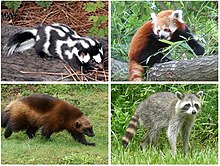Musteloidea
| Musteloidea Temporal range:
| |
|---|---|

| |
| Left-right: spotted skunk, red panda, wolverine and raccoon; representing the families Mephitidae, Ailuridae, Mustelidae and Procyonidae. | |
| Scientific classification | |
| Domain: | Eukaryota |
| Kingdom: | Animalia |
| Phylum: | Chordata |
| Class: | Mammalia |
| Order: | Carnivora |
| Infraorder: | Arctoidea |
| Superfamily: | Musteloidea Fischer , 1817
|
| Families | |
| |
Musteloidea is a
superfamily of carnivoran mammals united by shared characteristics of the skull and teeth. Musteloids are the sister group of pinnipeds, the group which includes seals.[1]
Musteloidea comprises the following families:
- Mephitidae, the skunks and stink badgers.
- .
- ringtails and cacomistles.
In
ursids (bears) and musteloids first appeared in the Chadronian[citation needed] of the late Eocene, and in early-Oligocene Europe, immediately following the Grande Coupure
extinction event.
The following
molecular phylogeny of six genes in Flynn (2005),[2] with the musteloids updated following the multigene analysis of Law et al. (2018).[3]
| Caniformia |
| |||||||||||||||||||||||||||||||||
